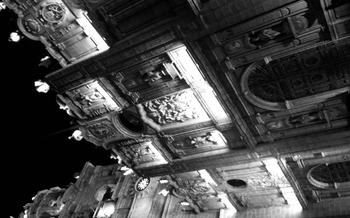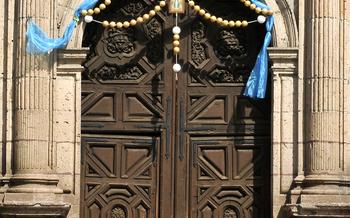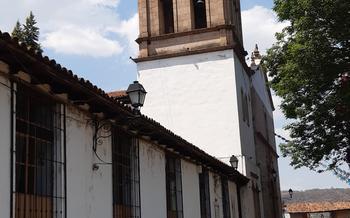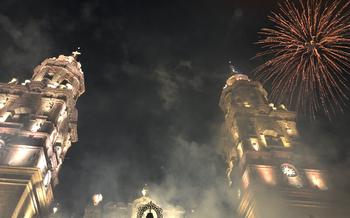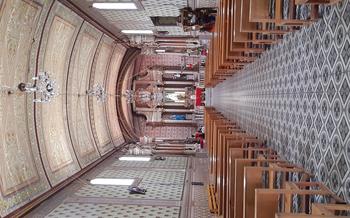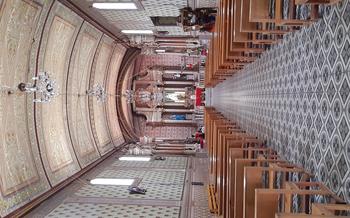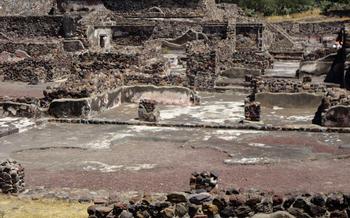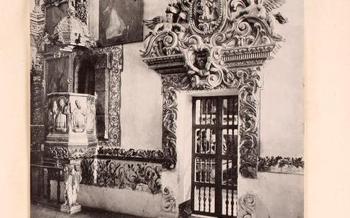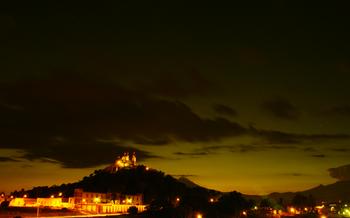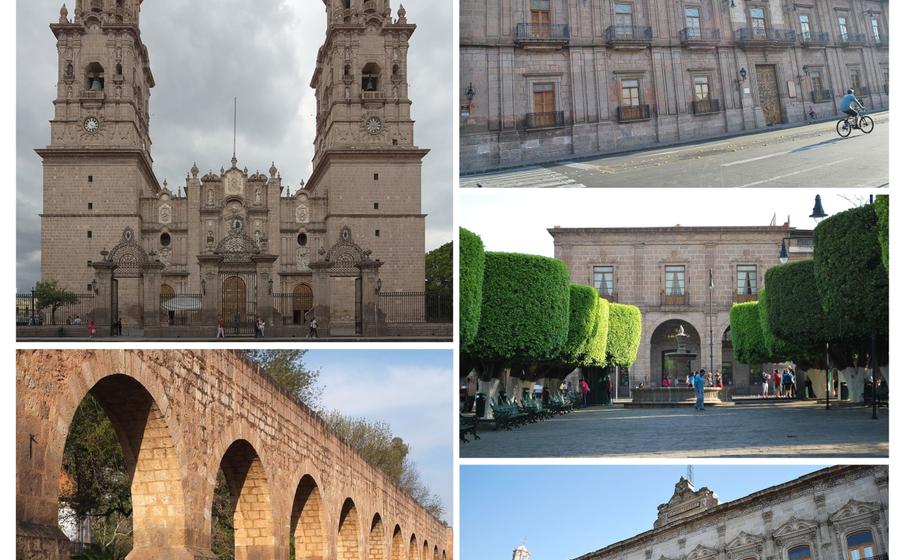
Templo y ex convento de Santa Ana en Tzintzuntzan
- Significance
- A Glimpse into the Past: Exploring the Museum
- A Place for Reflection: The Church's Interior
- A Panoramic Vista: The Surrounding Landscapes
- A Journey Through Time: The History of Tzintzuntzan
- A Sacred Site: Religious Significance
- A Symbol of Resilience: Overcoming Challenges
- A Path of Pilgrimage: The Walk to the Temple
- A Rich Tapestry: The Art and Architecture
- A Living Tradition: Festivals and Celebrations
- A Place of Learning: The Educational Programs
- A Community Effort: The Role of Volunteers
- A Haven for Nature Lovers: The Surrounding Area
Significance
The Templo y ex convento de Santa Ana en Tzintz. Constructed in the 16th century by the Franciscan missionaries, this architectural marvel showcases a harmonious blend of Spanish and indigenous design elements. Its unique features, including its impressive atrium with a fountain and a sundial, set it apart from other religious structures in the area.
The climb to the temple, though physically challenging, is a rewarding experience. Ascending the steep stone steps, visitors are greeted by breathtaking panoramic views of Lake Pátzcuaro and the surrounding mountains. This scenic vista offers a glimpse into the natural beauty that encompasses Tzintzuntzan, making the effort of the climb worthwhile.
The temple's historical significance lies in its role as a central figure in the evangelization of the Purépecha people. It served as a religious and educational center, contributing to the spread of Christianity and the assimilation of indigenous beliefs into the Catholic faith. The temple's enduring presence through the centuries speaks to its deep-rooted importance in the community and its pivotal role in shaping the religious and cultural landscape of Tzintzuntzan.
A Glimpse into the Past: Exploring the Museum
Nestuntzan, the small yet captivating museum offers a unique glimpse into the rich history and cultural heritage of the region. Through a carefully curated collection of artifacts, exhibits, and interactive displays, visitors are invited on a journey through time, exploring the significance of this sacred site and its role in shaping the identity of Tzintzuntzan.
The museum's collection showcases a diverse array of objects, from ancient pottery and tools to religious relics and colonial-era documents. These artifacts provide tangible evidence of the area's pre-Hispanic past, the arrival of the Spanish, and the subsequent blending of cultures that gave rise to the unique traditions and customs of the region.
Beyond its historical significance, the museum plays a vital role in preserving and promoting the cultural heritage of Tzintzuntzan. Through interactive exhibits and educational programs, visitors gain a deeper understanding of the town's history, its people, and the enduring legacy of the Purépecha civilization.
The museum's location within the temple complex further enhances its significance. Situated adjacent to the church, it offers visitors a comprehensive exploration of the site's religious, cultural, and historical dimensions. Together, the museum and the temple provide a profound and immersive experience that allows visitors to connect with the spirit and heritage of Tzintzuntzan.
A Place for Reflection: The Church's Interior
The interior of the-inspiring grandeur that leaves visitors breathless. The church's architecture is a testament to the skill and devotion of the builders, with its soaring arches, intricate carvings, and vibrant frescoes. The air is filled with a sense of peace and tranquility, inviting visitors to pause and reflect on the spiritual significance of this sacred space.
The church's interior is adorned with an array of religious artwork, each piece carefully chosen to enhance the spiritual experience of the faithful. The altarpiece, a masterpiece of colonial art, depicts scenes from the life of Saint Anne, the patron saint of the temple. The walls are lined with vivid murals, telling stories from the Bible and the history of the Purépecha people. These works of art serve as a visual reminder of the rich spiritual heritage that permeates this sacred space.
Whether you are a devout believer seeking solace or a curious traveler seeking to understand the region's cultural heritage, the interior of the Templo y ex convento de Santa Ana en Tzintzuntzan offers a profound and moving experience. It is a place where the beauty of art, the power of faith, and the tranquility of the surroundings combine to create a truly spiritual sanctuary.
A Panoramic Vista: The Surrounding Landscapes
The Templo y Pátzcuaro and the surrounding mountains. This spectacular natural backdrop enhances the temple's allure and provides visitors with a truly immersive experience. The shimmering waters of the lake reflect the changing colors of the sky, creating a picturesque vista that is sure to captivate the senses. The distant mountain peaks, cloaked in mist and greenery, add a majestic touch to the landscape, inviting visitors to explore the region's natural wonders.
The lake holds immense cultural and historical significance for the Purépecha people, who have inhabited the area for centuries. It was a crucial source of sustenance, providing food, water, and transportation routes. The lake's islands were also considered sacred places, hosting religious ceremonies and rituals. Visitors can appreciate the deep connection between the Purépecha people and Lake Pátzcuaro as they marvel at the breathtaking views from the temple.
The location of the temple atop a hill further enhances the panoramic vistas. The climb to the temple rewards visitors with a gradual unfolding of the landscape, revealing new perspectives and vistas with each step. This journey allows visitors to appreciate the beauty of the surroundings and the harmonious integration of the temple into the natural environment.
Whether capturing the golden hues of sunrise over the lake or the tranquil glow of sunset over the mountains, the Templo y ex convento de Santa Ana en Tzintzuntzan offers unparalleled opportunities for photography enthusiasts to immortalize the region's natural splendor. The surrounding landscapes serve as a stunning backdrop for capturing memorable images that will transport viewers into the heart of this enchanting region.
A Journey Through Time: The History of Tzintzuntzan
Tzintzuntzan holds a rich and fascinating history, deeply intertwined with the rise and fall of the Purépecha Empire, one of the most powerful pre-Hispanic civilizations in Mesoamerica. Once a thriving capital, Tzintzuntzan witnessed the arrival of the Spanish in the 16th century, leading to the establishment of a colonial town. During this time, the Templo y ex convento de Santa Ana en Tzintzuntzan played a pivotal role as a religious and cultural center. In the 20th century, the town was significantly impacted by the Mexican Revolution, which brought about social and political changes that shaped the region's identity. The temple, having endured these historical shifts, stands as a testament to Tzintzuntzan's resilience and its enduring legacy as a place of historical significance.
A Sacred Site: Religious Significance
The Templo y ex convento de Santa Ana en Tzintzuntzan holds immense religious significance for the local community and beyond. As a place of worship, the temple serves as the spiritual heart of the town. Dedicated to Saint Anne, the patron saint of Tzintzuntzan, the temple draws devotees throughout the year.
-
Religious Festivals: The temple is the focal point of annual festivals honoring Saint Anne and other religious figures. These vibrant celebrations, deeply rooted in local traditions, showcase the community's devotion and cultural heritage.
-
Spiritual Energy: Visitors to the temple often remark on the palpable spiritual energy that permeates the atmosphere. The church's tranquil ambiance invites reflection and contemplation, fostering a sense of peace and serenity.
-
Community Gatherings: Beyond religious festivals, the temple serves as a gathering place for the community. Local residents come together for prayers, masses, and other religious events, strengthening their spiritual bonds and sense of belonging.
A Symbol of Resilience: Overcoming Challenges
Despite the challenges ituntzan has endured as a testament to the strength and resilience of the local community. Over the centuries, the temple has withstood numerous earthquakes and other natural disasters, each time undergoing meticulous restoration and preservation efforts. The community's unwavering dedication to maintaining the temple's legacy is a testament to its cultural and historical significance. Today, the temple stands as a symbol of strength and resilience, inspiring awe and admiration in visitors who witness its enduring beauty.
A Path of Pilgrimage: The Walk to the Temple
For centuries, pilgrims have made the arduous journey to the Templo y ex convento de Santa Ana en Tzintzuntzan on foot, following a tradition that dates back to pre-Hispanic times. The walk, which can take several hours or even days, is seen as a physical and spiritual challenge, a way to show devotion and connect with the sacred site.
The path winds through picturesque landscapes, passing by small villages and fields, offering pilgrims a chance to immerse themselves in the region's natural beauty. Along the way, they may encounter other pilgrims, sharing stories and experiences, fostering a sense of community and camaraderie.
The physical demands of the journey are significant, as the route can be steep and rocky in places, requiring endurance and determination. However, the challenges are often seen as a metaphor for the spiritual journey, a test of faith and resilience.
Upon reaching the temple, pilgrims are often filled with a sense of accomplishment and spiritual fulfillment. The journey itself becomes a transformative experience, deepening their connection to the sacred site and the community, and leaving a lasting impact on their lives.
A Rich Tapestry: The Art and Architecture
The Templo y of Spanish and indigenous artistic styles. The church's exterior boasts intricate carvings that depict scenes from the Bible and the lives of saints, while the interior is adorned with colorful frescoes that tell stories of the region's history and culture. The symbolism and religious significance of the artwork are evident throughout the temple, from the elaborate altarpieces to the stained-glass windows. Visitors are drawn to the temple's beauty, which has made it a popular destination for art enthusiasts and historians alike. The fusion of artistic traditions in the Templo y ex convento de Santa Ana en Tzintzuntzan is a reminder of the rich cultural heritage of the region and the enduring legacy of its people.
A Living Tradition: Festivals and Celebrations
The Templo y ex convento de Santa Ana en Tzintzuntzan is not just a historical and architectural wonder; it is also a living tradition, deeply embedded in the cultural fabric of the local community. Throughout the year, the temple plays host to a variety of festivals and celebrations that showcase the vibrant cultural heritage of Tzintzuntzan.
One of the most important festivals is the annual celebration in honor of the patron saint, Santa Ana, which takes place in July. During this week-long event, the town comes alive with music, dance, and traditional festivities. The streets are adorned with colorful decorations, and the air is filled with the sounds of traditional music and the laughter of locals and visitors alike.
Other notable festivals include the Day of the Dead celebrations in November, when families gather at the temple to honor their deceased loved ones and create elaborate altars adorned with flowers, candles, and offerings. The Christmas season is also a time of great celebration in Tzintzuntzan, with the temple serving as the focal point for community gatherings, nativity scenes, and traditional posadas.
These festivals and celebrations are not just religious events; they are also opportunities for the community to come together, share their traditions, and celebrate their cultural heritage. Visitors to Tzintzuntzan during these times are treated to a unique and immersive experience, gaining a deeper understanding of the town's rich history and vibrant cultural traditions.
A Place of Learning: The Educational Programs
**The Templo y ex convento site but also a place of learning and education. The temple authorities, in collaboration with educational institutions, offer a range of educational programs to students and visitors, fostering a deeper understanding of the region's rich history and culture.
These programs cover various aspects, including the temple's architectural significance, the history of Tzintzuntzan, the fusion of Spanish and indigenous cultures, and the preservation of cultural heritage. Through interactive displays, guided tours, and workshops, visitors can delve into the fascinating stories and traditions associated with the temple and the surrounding area.
The educational programs play a crucial role in raising awareness about the importance of preserving cultural heritage and promoting cultural identity among the younger generations. By engaging with the temple's history and significance, students and visitors gain a deeper appreciation for the region's unique cultural tapestry and the ongoing efforts to safeguard it for future generations.
A Community Effort: The Role of Volunteers
Volunteers, the Guardians of Heritage
Preserving cultural heritage is a collective endeavor, and at the Templo y ex convento de Santa Ana en Tzintzuntzan, volunteers play a crucial role. Their dedication and hard work are instrumental in maintaining and protecting this architectural gem.
These passionate individuals perform a variety of tasks to ensure the temple's longevity. They engage in restoration work, carefully repairing and conserving the intricate details that make the temple unique. They also serve as guides, sharing the temple's history and significance with visitors from around the world.
A Labor of Love
For these volunteers, their work is a labor of love. They are driven by a deep sense of pride in their community and a desire to preserve their cultural heritage for future generations. Through their efforts, they are not only protecting a physical structure but also safeguarding the traditions and stories that give Tzintzuntzan its identity.
A Sense of Fulfillment
The volunteers at Templo y ex convento de Santa Ana en Tzintzuntzan derive immense satisfaction from their contributions. They witness firsthand the positive impact of their work as they see the temple flourish and visitors marvel at its beauty. The sense of community and shared purpose among the volunteers fosters a strong bond and a deep appreciation for their shared heritage.
A Call to Action
The dedication of these volunteers serves as an inspiration to us all. Their tireless efforts remind us of the importance of preserving our cultural heritage and the role that each of us can play in protecting and celebrating the treasures of our communities.
A Haven for Nature Lovers: The Surrounding Area
Surrounded by the captivating beauty of nature, the Templo y ex convento de Santa Ana en Tzintzuntzan offers a unique opportunity for visitors to immerse themselves in the region's natural wonders. The surrounding mountains, forests, and Lake Pátzcuaro provide a breathtaking backdrop to this historic site, inviting nature enthusiasts to explore the diverse ecosystems that thrive here.
Whether you're an avid hiker, a birdwatching enthusiast, or simply seeking tranquility amidst nature, the area surrounding the temple offers a wealth of opportunities. Lace up your hiking boots and embark on a journey through the picturesque mountains, discovering hidden waterfalls and panoramic viewpoints that will take your breath away. As you wander through the lush forests, keep your eyes peeled for a glimpse of the region's diverse birdlife, including hummingbirds, woodpeckers, and eagles soaring overhead.
For those who prefer a more leisurely experience, a stroll along the shores of Lake Pátzcuaro offers a serene escape. Take in the tranquil beauty of the lake's shimmering waters, dotted with colorful fishing boats and surrounded by verdant hills. Whether you choose to hike, birdwatch, or simply soak in the natural splendor, the surroundings of the Templo y ex convento de Santa Ana en Tzintzuntzan provide a sanctuary for nature lovers, inviting you to connect with the region's rich biodiversity and find solace in the embrace of nature.
